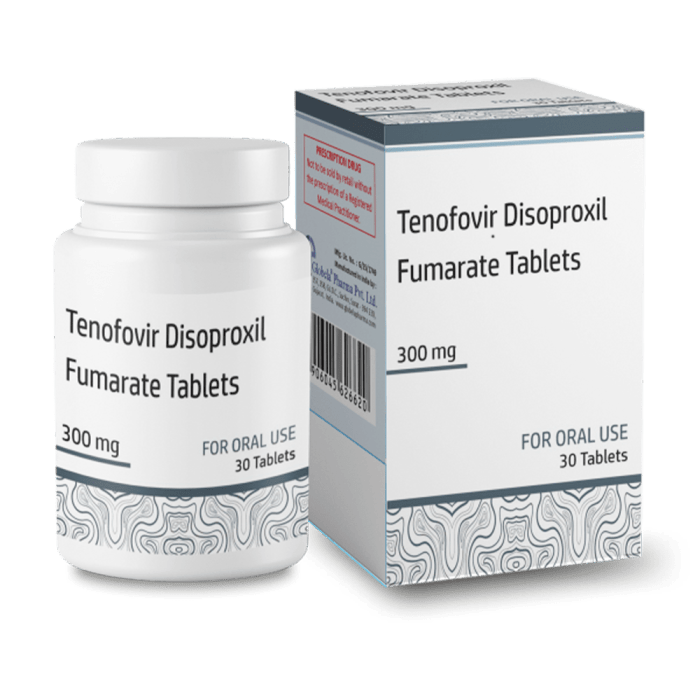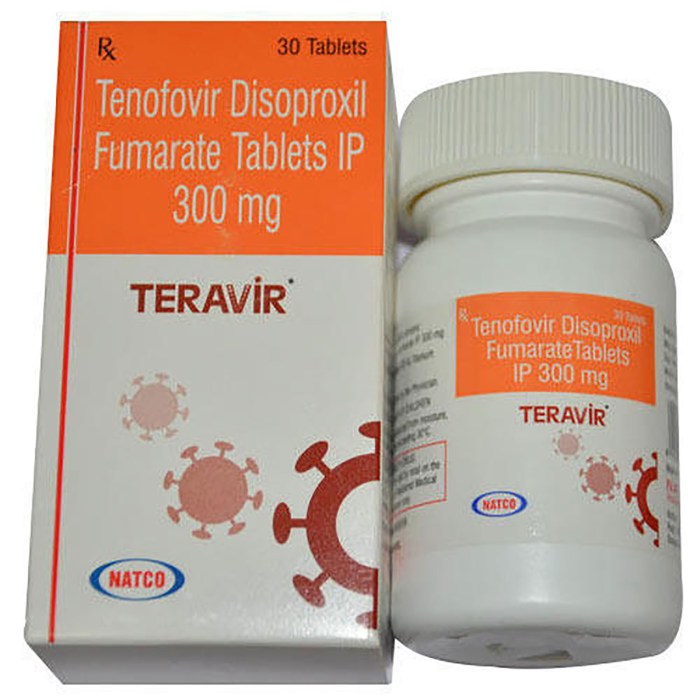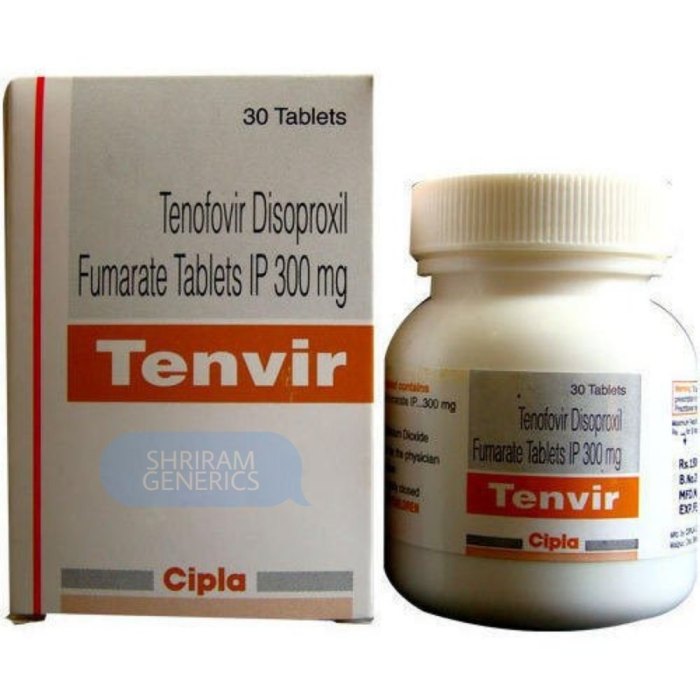Tenofovir, a potent antiviral medication, has revolutionized the treatment of HIV and chronic hepatitis B infections. Its unique mechanism of action targets a crucial enzyme in the viral life cycle, effectively inhibiting viral replication and preventing disease progression. Tenofovir is available in various formulations, each tailored to specific patient needs and treatment goals.
Since its introduction, tenofovir has become a cornerstone of antiretroviral therapy, significantly improving the lives of countless individuals living with HIV. Its efficacy, combined with a generally favorable safety profile, has solidified its position as a vital tool in the fight against these debilitating diseases.
Mechanism of Action
Tenofovir is a nucleoside analog reverse transcriptase inhibitor (NRTI) that effectively combats HIV infection. It functions by interfering with the crucial process of viral replication, specifically by targeting the enzyme reverse transcriptase.
Mechanism of Action
Tenofovir’s mechanism of action centers around its ability to inhibit the activity of reverse transcriptase, a vital enzyme employed by HIV to convert its RNA genetic material into DNA. This DNA is then integrated into the host cell’s genome, enabling the virus to replicate and spread.
Tenofovir acts as a “molecular imposter,” mimicking the natural building blocks of DNA, known as deoxyadenosine triphosphate (dATP). However, tenofovir lacks the essential 3′-hydroxyl group required for DNA chain elongation. This structural difference prevents the addition of further nucleotides to the growing DNA chain, effectively halting the process of reverse transcription.
Tenofovir, a nucleoside analog, inhibits reverse transcriptase by acting as a chain terminator.
The inhibition of reverse transcription disrupts the viral life cycle, hindering the production of new viral particles and ultimately suppressing viral replication.
Target of Tenofovir within the Viral Life Cycle
Tenofovir specifically targets the reverse transcriptase enzyme during the early stages of the HIV life cycle. Reverse transcriptase plays a crucial role in the conversion of viral RNA into DNA, which is a necessary step for HIV to integrate its genetic material into the host cell’s genome.
Tenofovir’s ability to inhibit reverse transcriptase prevents this crucial step, effectively blocking the viral replication process.
Clinical Applications

Tenofovir is a potent antiviral medication with a wide range of clinical applications. Its primary use is in the treatment of viral infections, particularly HIV and hepatitis B. This section will delve into the specific conditions treated with tenofovir and the various treatment regimens that incorporate this medication.
Conditions Treated with Tenofovir
Tenofovir is a cornerstone medication for the management of both HIV and hepatitis B infections. It is effective in suppressing viral replication and reducing the risk of complications associated with these conditions.
- HIV Infection: Tenofovir is a crucial component of antiretroviral therapy (ART) for HIV-infected individuals. It effectively inhibits the activity of the HIV reverse transcriptase enzyme, preventing the virus from replicating and spreading.
- Hepatitis B Infection: Tenofovir is a highly effective treatment for chronic hepatitis B infection. It suppresses viral replication and reduces the risk of liver damage, cirrhosis, and liver cancer.
Treatment Regimens
Tenofovir is typically administered in combination with other antiretroviral medications, forming a comprehensive ART regimen. The specific regimen may vary depending on the individual’s viral load, health status, and other factors.
- HIV Treatment: Tenofovir is often combined with other antiretroviral agents, such as emtricitabine, efavirenz, or dolutegravir. This combination therapy aims to suppress HIV replication effectively and maintain viral suppression.
- Hepatitis B Treatment: Tenofovir is typically administered as a single daily dose for chronic hepatitis B infection. The duration of treatment can vary depending on the individual’s response to therapy and the presence of liver disease.
Safety and Side Effects
Tenofovir is generally well-tolerated, but like all medications, it can cause side effects. These side effects can range from mild and temporary to serious and potentially life-threatening. It is important to be aware of the potential risks associated with tenofovir use and to discuss any concerns with your healthcare provider.
Common Adverse Effects
Common side effects of tenofovir are generally mild and tend to resolve on their own. These include:
- Nausea
- Diarrhea
- Abdominal pain
- Headache
- Fatigue
- Rash
Serious Adverse Events
While less common, serious adverse events can occur with tenofovir use. These include:
- Renal Impairment: Tenofovir can damage the kidneys, especially in individuals with pre-existing kidney disease or those taking other nephrotoxic medications. This can lead to a decline in kidney function, potentially requiring dialysis.
- Hepatic Impairment: Tenofovir can also affect the liver, particularly in individuals with pre-existing liver disease. This can lead to liver inflammation (hepatitis) or even liver failure.
- Bone Health Issues: Tenofovir can decrease bone mineral density, increasing the risk of fractures, especially in individuals with osteoporosis or other bone health conditions.
- Lactic Acidosis: A rare but serious complication associated with tenofovir use, particularly in individuals with HIV infection. Lactic acidosis is a buildup of lactic acid in the blood, which can lead to fatigue, weakness, nausea, and even death.
Contraindications and Precautions
Tenofovir is contraindicated in individuals with:
- Severe kidney disease
- Severe liver disease
- Known hypersensitivity to tenofovir or any of its ingredients
Precautions should be taken when administering tenofovir to individuals with:
- Kidney disease: Dosage adjustments may be necessary to minimize the risk of kidney damage. Regular monitoring of kidney function is essential.
- Liver disease: Dosage adjustments may be necessary to minimize the risk of liver damage. Regular monitoring of liver function is essential.
- Bone health issues: Individuals with osteoporosis or other bone health conditions should be monitored for bone mineral density changes. Calcium and vitamin D supplementation may be considered.
- Pregnancy: Tenofovir can be harmful to the developing fetus. It is not recommended for use during pregnancy unless the benefits outweigh the risks.
- Breastfeeding: Tenofovir can be excreted in breast milk. It is not recommended for use during breastfeeding unless the benefits outweigh the risks.
Tenofovir Resistance
Tenofovir resistance is a significant concern in the management of HIV infection. It occurs when the virus develops mutations that allow it to evade the antiviral effects of tenofovir. Understanding the mechanisms of tenofovir resistance, its clinical implications, and strategies for managing it is crucial for optimizing HIV treatment outcomes.
Mechanisms of Tenofovir Resistance
Tenofovir resistance arises from mutations in the HIV reverse transcriptase (RT) gene. These mutations primarily occur in the active site of the enzyme, where tenofovir binds. The most common mutations associated with tenofovir resistance are:
- K65R: This mutation is the most frequent and is associated with a significant reduction in tenofovir’s antiviral activity. The substitution of lysine (K) with arginine (R) at position 65 in the RT gene disrupts tenofovir binding and reduces its ability to inhibit viral replication.
- M184V: This mutation is often observed in combination with K65R and can further enhance tenofovir resistance. It involves the substitution of methionine (M) with valine (V) at position 184 in the RT gene, leading to a conformational change that reduces tenofovir’s affinity for the enzyme.
- L74V: This mutation, although less common, can also contribute to tenofovir resistance. It involves the substitution of leucine (L) with valine (V) at position 74 in the RT gene, resulting in a slight decrease in tenofovir’s inhibitory activity.
Clinical Implications of Tenofovir Resistance
Tenofovir resistance can have significant clinical implications for HIV-infected individuals. It can lead to:
- Treatment Failure: Tenofovir resistance can result in treatment failure, characterized by an increase in viral load and a decline in CD4+ T cell count. This can increase the risk of opportunistic infections and disease progression.
- Limited Treatment Options: Once tenofovir resistance develops, the choice of effective antiretroviral therapy becomes limited. This can necessitate the use of alternative drugs, which may have different side effects or require complex treatment regimens.
- Increased Risk of Transmission: Individuals with tenofovir-resistant HIV have a higher risk of transmitting the virus to others. This is because the virus is less susceptible to tenofovir, making it more likely to replicate and spread.
Strategies for Managing Tenofovir Resistance
Managing tenofovir resistance requires a multi-pronged approach:
- Genotypic Testing: Regular genotypic testing can identify the presence of tenofovir resistance mutations. This allows for timely adjustments to the treatment regimen.
- Drug Substitution: If tenofovir resistance is confirmed, alternative antiretroviral drugs should be used to replace tenofovir. The choice of alternative drugs will depend on the specific resistance mutations present and the patient’s overall clinical profile.
- Adherence to Treatment: Strict adherence to the prescribed antiretroviral regimen is crucial to prevent the development of resistance. Missed doses or incomplete treatment courses can increase the risk of resistance emergence.
- Prevention of Transmission: Individuals with tenofovir-resistant HIV should take steps to prevent transmission, such as consistent condom use and adherence to antiretroviral therapy.
Tenofovir in Combination Therapy

Tenofovir is rarely used as a monotherapy for HIV treatment. Its primary role is in combination regimens, which offer significant advantages over single-drug therapy.
Combining tenofovir with other antiretroviral agents is crucial for effective HIV management. This approach addresses several key aspects of HIV infection, leading to better outcomes for patients.
Rationale for Combination Therapy
The use of tenofovir in combination regimens is based on the following rationale:
* Suppression of Viral Replication: Combining different antiretroviral drugs with distinct mechanisms of action targets multiple stages of the HIV lifecycle. This prevents the virus from developing resistance to any single drug and effectively suppresses viral replication.
* Prevention of Resistance: The use of multiple drugs reduces the likelihood of the virus developing resistance to any single drug. This is essential for long-term viral suppression and maintaining treatment effectiveness.
* Enhanced Efficacy: Combining tenofovir with other antiretroviral agents leads to a more potent and sustained reduction in viral load. This translates to improved clinical outcomes, including a lower risk of opportunistic infections and disease progression.
* Improved Tolerability: Combining tenofovir with other drugs allows for lower doses of each individual drug, minimizing potential side effects and improving overall tolerability.
Examples of Tenofovir-Containing Combination Therapies
Several commonly used tenofovir-containing combination therapies are available, offering different drug combinations and formulations to cater to individual patient needs.
- Tenofovir Disoproxil Fumarate (TDF) + Emtricitabine (FTC) + Efavirenz (EFV): This combination is known as Atripla and is a single-tablet regimen for HIV treatment. It is a highly effective and well-tolerated combination, particularly for treatment-naïve patients.
- Tenofovir Disoproxil Fumarate (TDF) + Emtricitabine (FTC) + Raltegravir (RAL): This combination is known as Complera and is also a single-tablet regimen. It is an effective option for patients with prior exposure to antiretroviral therapy.
- Tenofovir Alafenamide (TAF) + Emtricitabine (FTC) + Bictegravir (BIC): This combination is known as Biktarvy and is a single-tablet regimen with a lower dose of tenofovir. It is a highly effective option for treatment-naïve patients and those with prior exposure to antiretroviral therapy.
- Tenofovir Alafenamide (TAF) + Emtricitabine (FTC) + Dolutegravir (DTG): This combination is known as Dovato and is a single-tablet regimen. It is a highly effective option for treatment-naïve patients and those with prior exposure to antiretroviral therapy.
These are just a few examples of tenofovir-containing combination therapies available. The specific regimen chosen for an individual patient depends on various factors, including their medical history, current health status, and prior treatment experience.
Tenofovir in Special Populations
Tenofovir’s use in special populations, such as pregnant women, children, and individuals with renal impairment, requires careful consideration and adjustment of dosage and monitoring to ensure safety and efficacy.
Tenofovir in Pregnancy
Tenofovir is classified as a category B drug for pregnancy, meaning that animal studies have not shown a risk to the fetus, but there are no adequate and well-controlled studies in pregnant women. While tenofovir is generally considered safe for use during pregnancy, it’s crucial to weigh the benefits against potential risks.
- The benefits of tenofovir for pregnant women with HIV include reducing the risk of mother-to-child transmission of the virus and improving the mother’s overall health.
- However, tenofovir can potentially affect fetal development, particularly in the first trimester. Some studies have suggested a possible association between tenofovir use during pregnancy and an increased risk of birth defects, although more research is needed to confirm this link.
- Close monitoring of pregnant women receiving tenofovir is essential, including regular fetal ultrasound scans and laboratory tests to assess fetal growth and development.
- Healthcare providers should carefully consider the potential risks and benefits of tenofovir use during pregnancy, taking into account the individual patient’s circumstances and the availability of alternative treatments.
Tenofovir in Children
Tenofovir is approved for use in children with HIV infection, but its use in this population requires careful consideration due to potential developmental effects.
- Tenofovir is generally well-tolerated in children, but some side effects, such as bone problems, may be more common in this age group.
- Dosage adjustments are necessary based on the child’s weight and age to ensure appropriate drug levels and minimize potential side effects.
- Regular monitoring of kidney function, bone health, and growth parameters is crucial in children receiving tenofovir.
- Healthcare providers should work closely with parents or guardians to provide appropriate education and support regarding tenofovir therapy.
Tenofovir in Renal Impairment
Tenofovir is primarily eliminated through the kidneys, so individuals with renal impairment are at increased risk of tenofovir accumulation and potential toxicity.
- Dosage adjustments are necessary based on the severity of renal impairment, with lower doses typically recommended for patients with reduced kidney function.
- Close monitoring of kidney function is essential in patients with renal impairment, including regular blood tests to assess creatinine levels and glomerular filtration rate (GFR).
- In patients with severe renal impairment, tenofovir may be contraindicated due to the increased risk of drug accumulation and adverse effects.
- Alternative antiretroviral medications may be considered for patients with significant renal impairment, depending on individual circumstances.
Future Directions

Tenofovir, a cornerstone of HIV treatment, continues to evolve with ongoing research and development efforts aimed at optimizing its efficacy, safety, and accessibility. New applications for tenofovir are also being explored, potentially expanding its therapeutic reach beyond HIV infection.
Ongoing Research and Development
Ongoing research focuses on enhancing tenofovir’s effectiveness and safety profile. Key areas of investigation include:
- Improved Formulations: Research is underway to develop more bioavailable and patient-friendly formulations of tenofovir. This includes exploring long-acting injectable formulations and oral formulations with improved absorption and reduced gastrointestinal side effects. For instance, tenofovir alafenamide (TAF), a newer formulation, demonstrates improved bioavailability and reduced renal toxicity compared to tenofovir disoproxil fumarate (TDF).
- Combination Therapies: Ongoing research investigates the combination of tenofovir with other antiretroviral agents to create more potent and durable treatment regimens. This includes exploring the potential for tenofovir to be combined with novel antiretroviral agents targeting different viral proteins or mechanisms of action. For example, the combination of tenofovir with integrase inhibitors like dolutegravir has shown significant efficacy in suppressing viral replication.
- Tenofovir Resistance: Research focuses on understanding the mechanisms of tenofovir resistance and developing strategies to overcome it. This includes identifying genetic mutations in the viral genome that confer resistance to tenofovir and exploring alternative drug regimens to manage resistance. For example, the use of tenofovir alafenamide (TAF) has been shown to reduce the emergence of resistance mutations compared to tenofovir disoproxil fumarate (TDF).
Potential New Applications, Tenofovir
Tenofovir’s antiviral properties extend beyond HIV, opening doors to potential applications in treating other viral infections:
- Hepatitis B Virus (HBV) Infection: Tenofovir has proven effective in suppressing HBV replication and preventing liver disease progression. Ongoing research explores its potential for long-term treatment and prevention of HBV infection, including its use in combination with other antiviral agents.
- Other Viral Infections: Preclinical studies suggest that tenofovir might have antiviral activity against other viruses, including influenza, dengue, and Zika virus. Further research is needed to evaluate its efficacy and safety in these contexts.
Emerging Challenges and Opportunities
Tenofovir research faces challenges and opportunities that shape its future direction:
- Tenofovir Resistance: While tenofovir has proven effective, the emergence of resistance remains a concern. Ongoing research aims to understand the mechanisms of resistance and develop strategies to overcome it. This includes exploring novel drug combinations and developing new drugs that target different viral proteins or mechanisms of action.
- Long-Term Safety: Long-term safety data for tenofovir is still being collected, particularly in specific populations like pregnant women and children. Continued monitoring and research are crucial to ensure its long-term safety and efficacy.
- Accessibility and Affordability: Access to tenofovir remains a challenge in many parts of the world, particularly in low- and middle-income countries. Efforts are underway to develop more affordable and accessible formulations and to expand access to treatment programs.
Tenofovir’s impact on the treatment of HIV and hepatitis B is undeniable. Its ability to suppress viral replication, coupled with ongoing research exploring its potential applications in other viral infections, underscores its importance in global health. As we continue to learn more about this remarkable drug, its role in combating infectious diseases is likely to expand, offering hope and improved outcomes for patients worldwide.
Tenofovir is a powerful antiviral medication used to treat HIV and hepatitis B. While it targets viral replication, it doesn’t affect other bodily systems like the respiratory system, which is where terbutaline , a bronchodilator, comes into play. Terbutaline helps open up airways, making it useful for conditions like asthma. Unlike tenofovir, terbutaline is not an antiviral, but rather focuses on improving lung function.